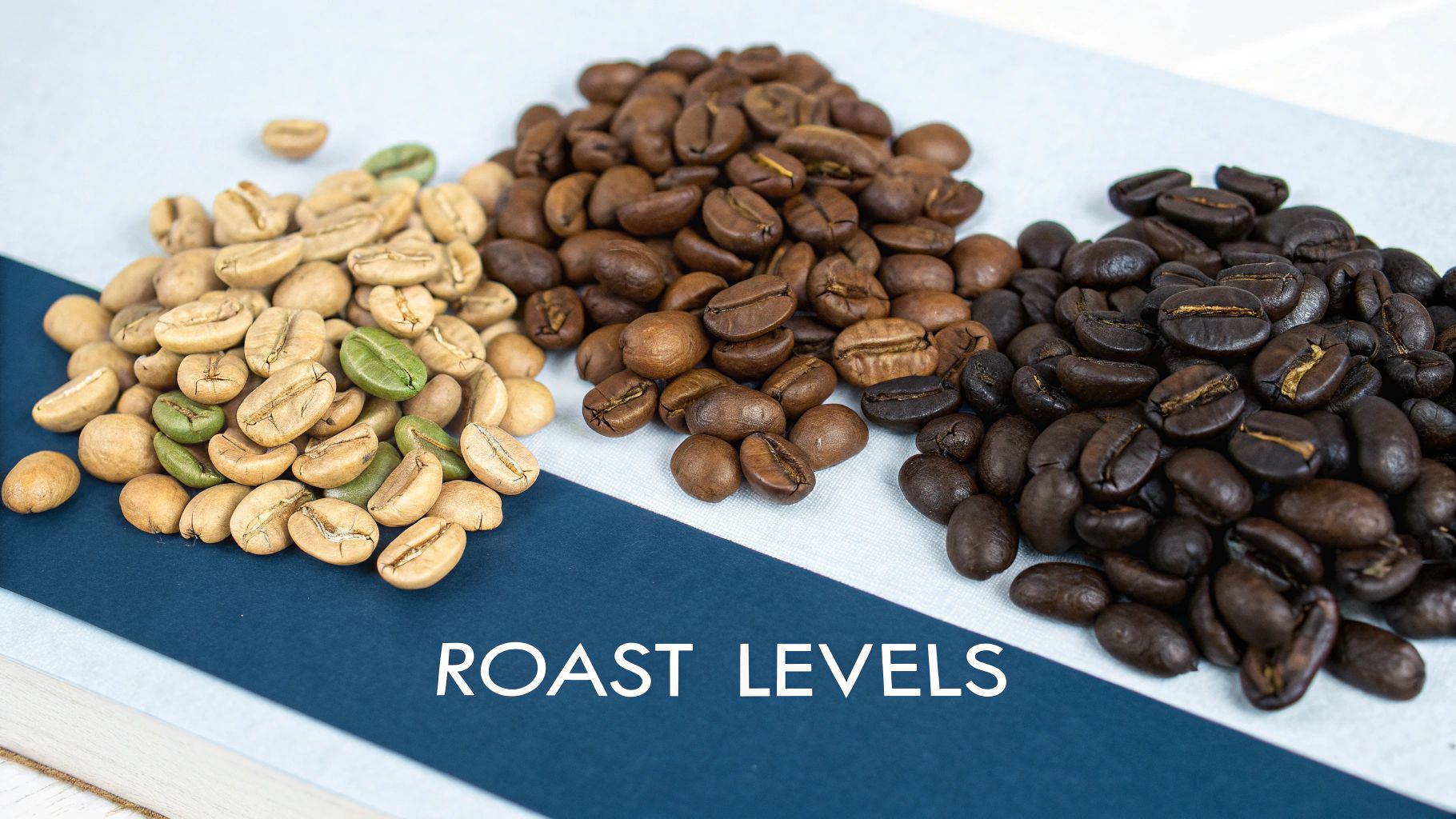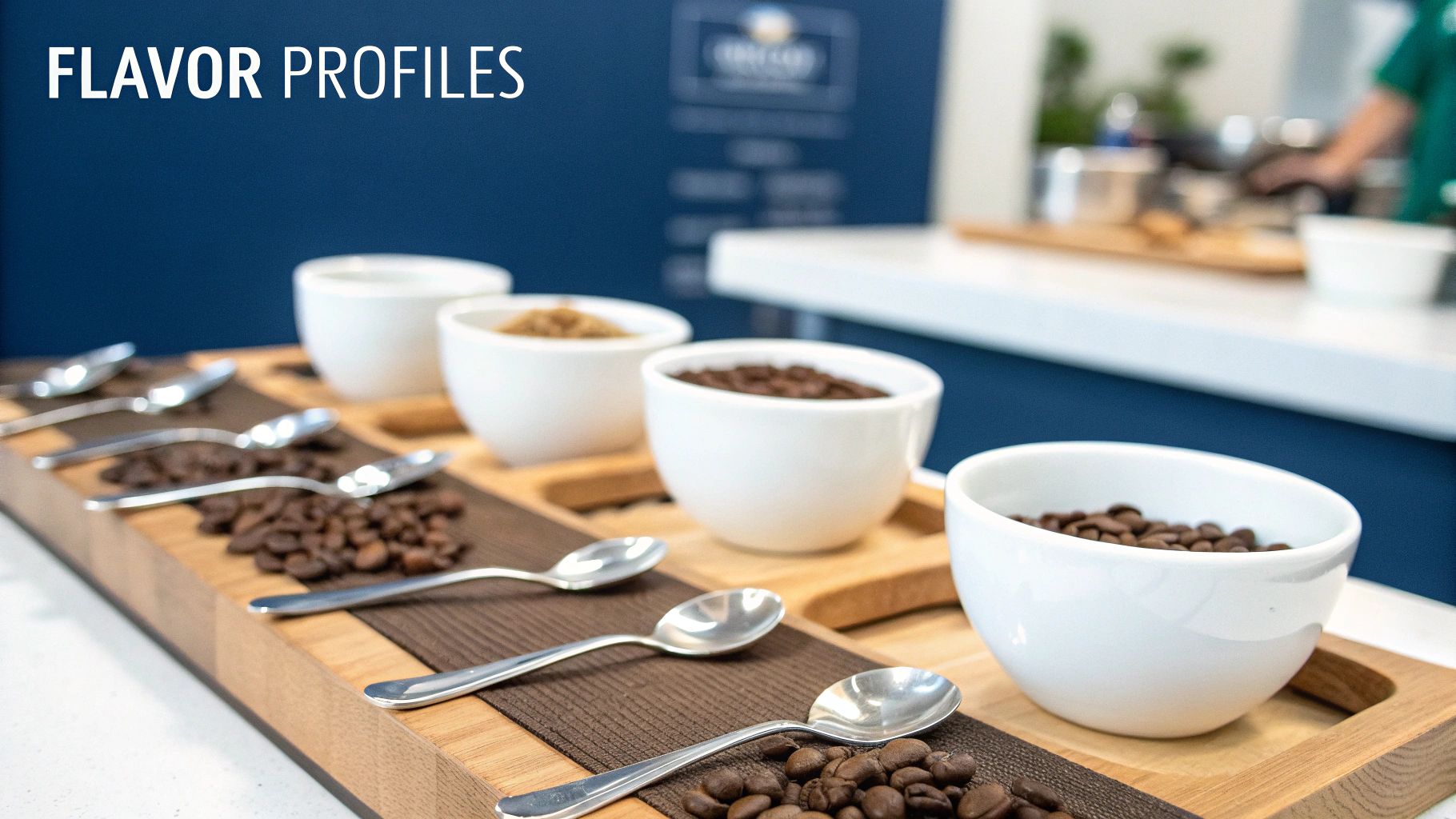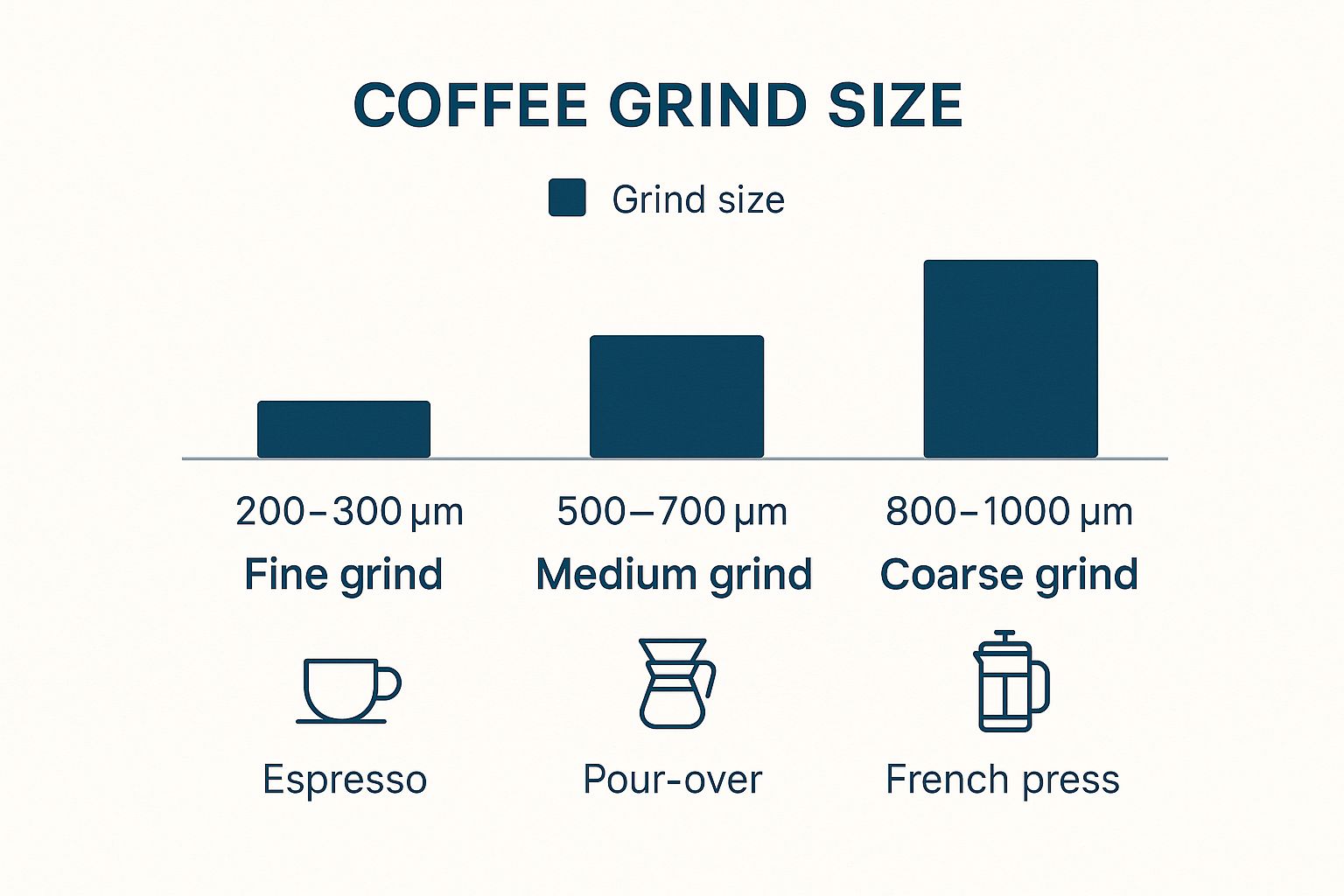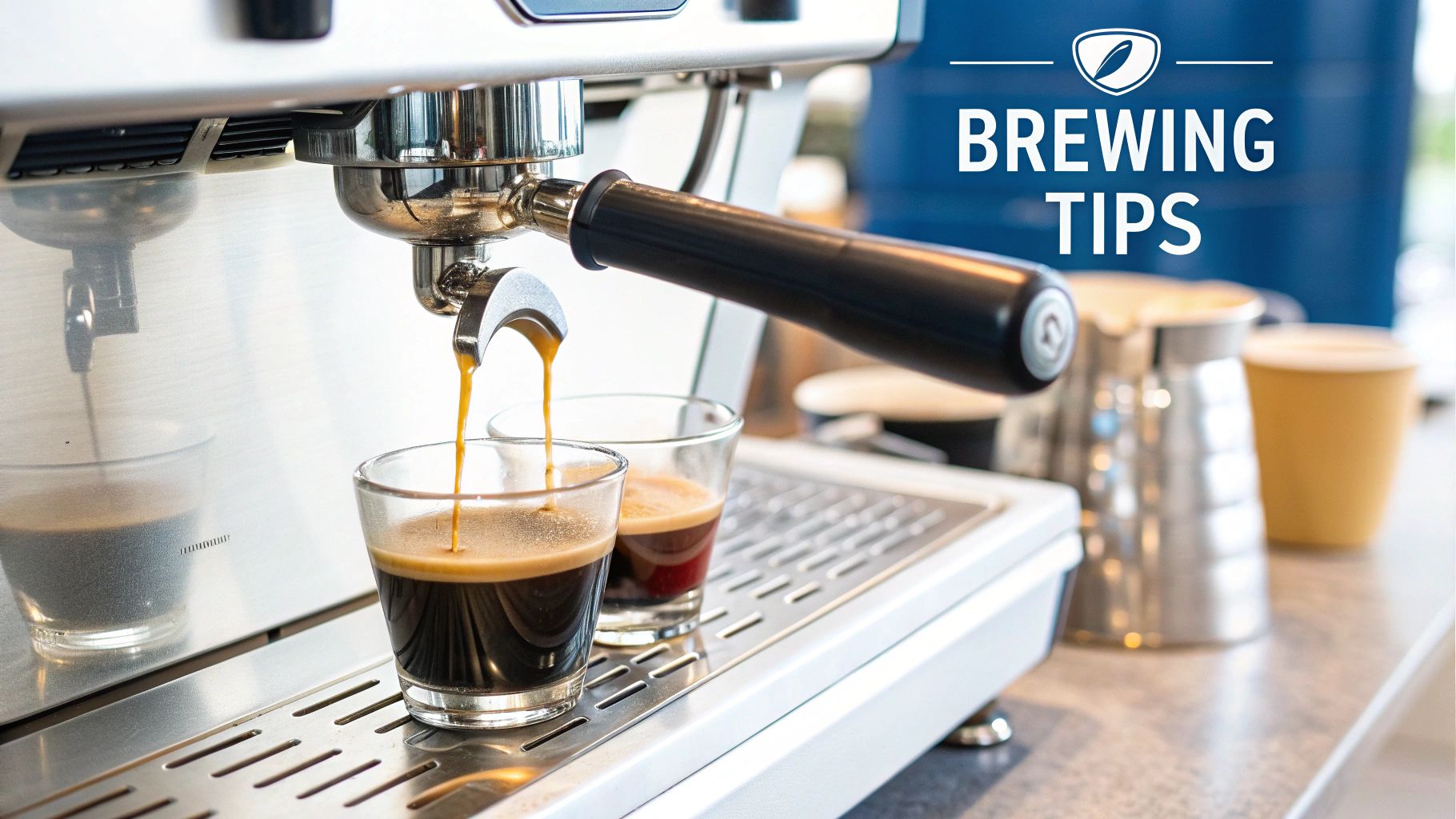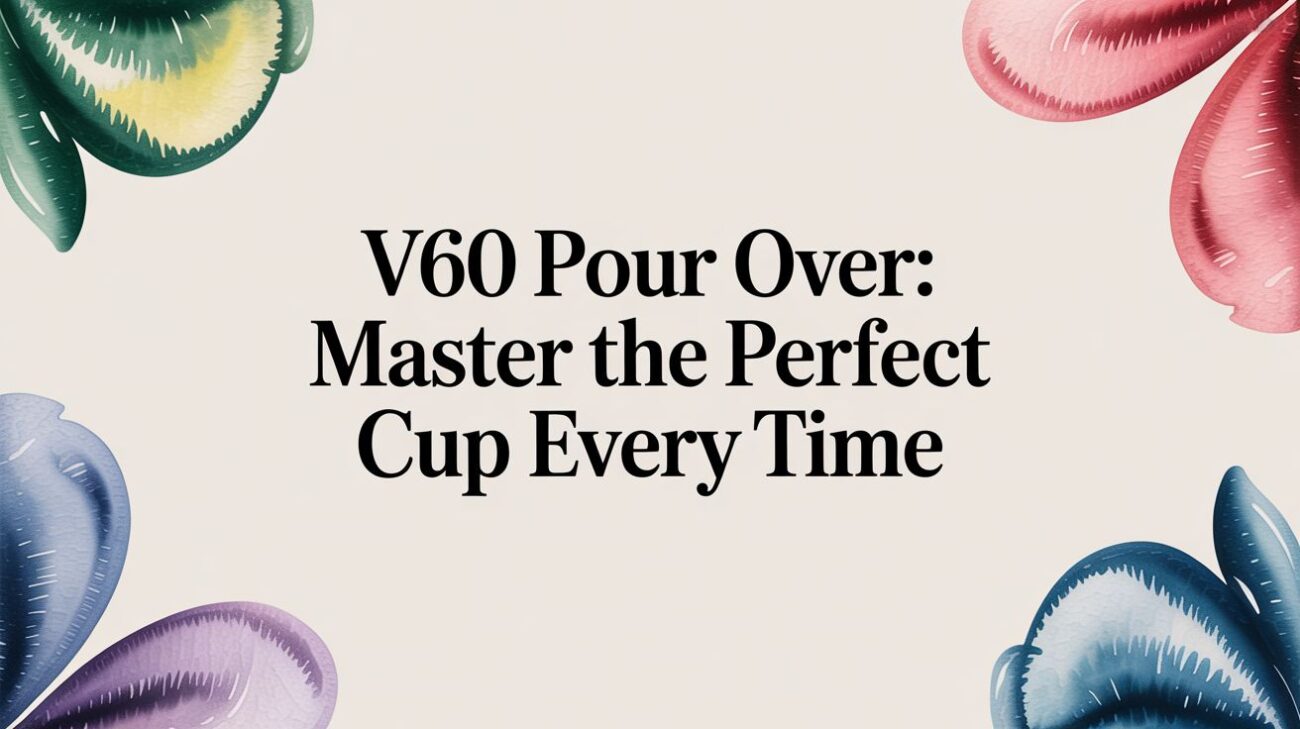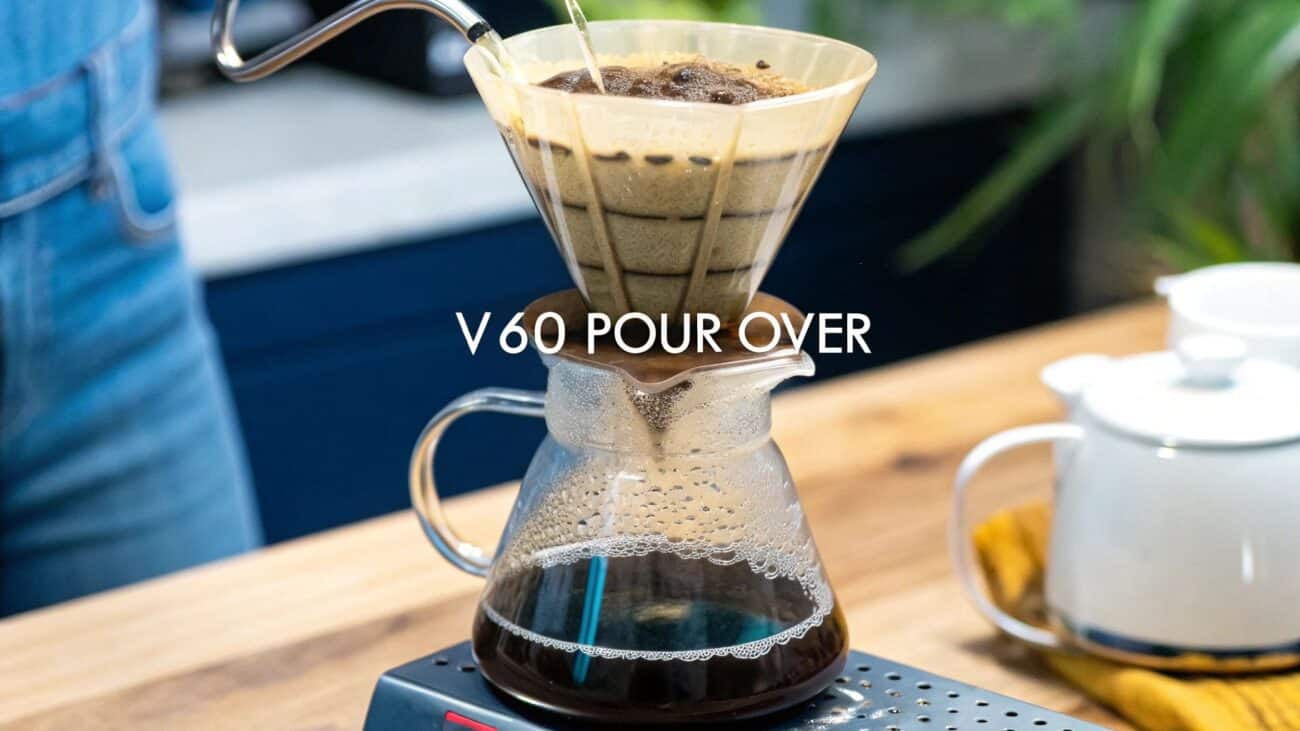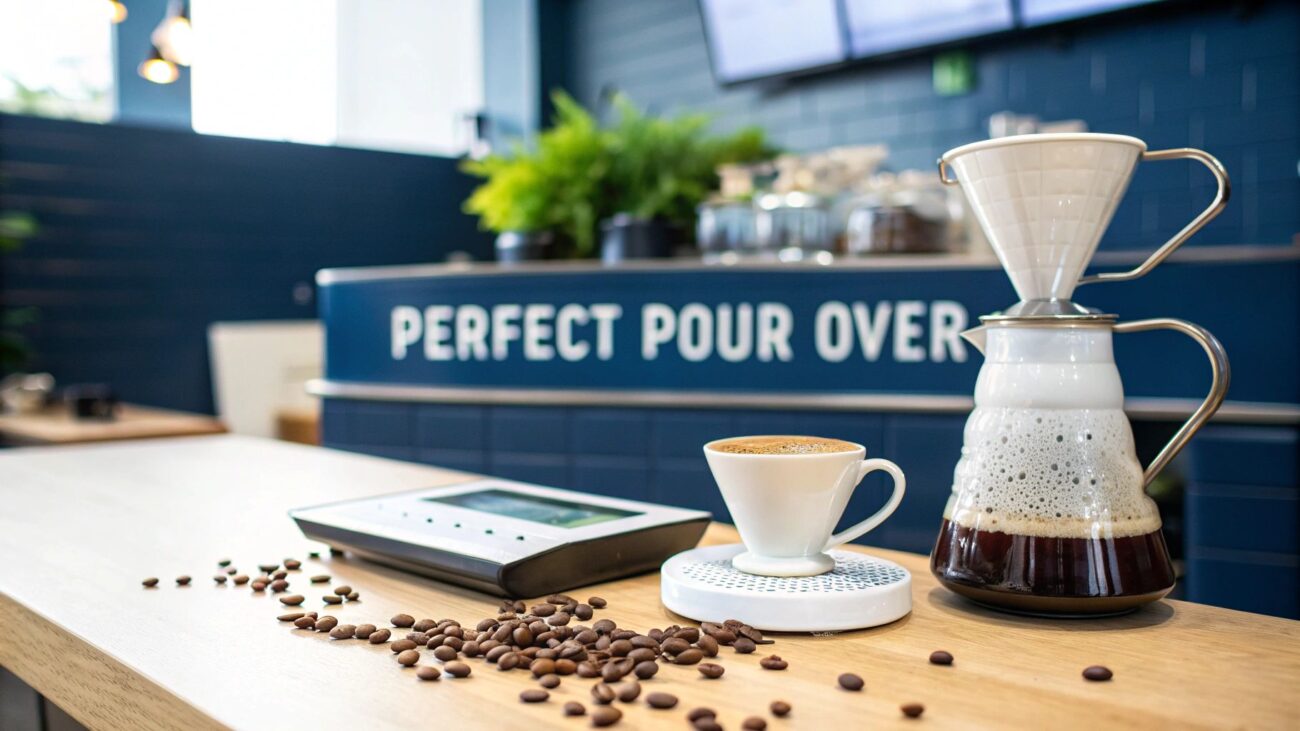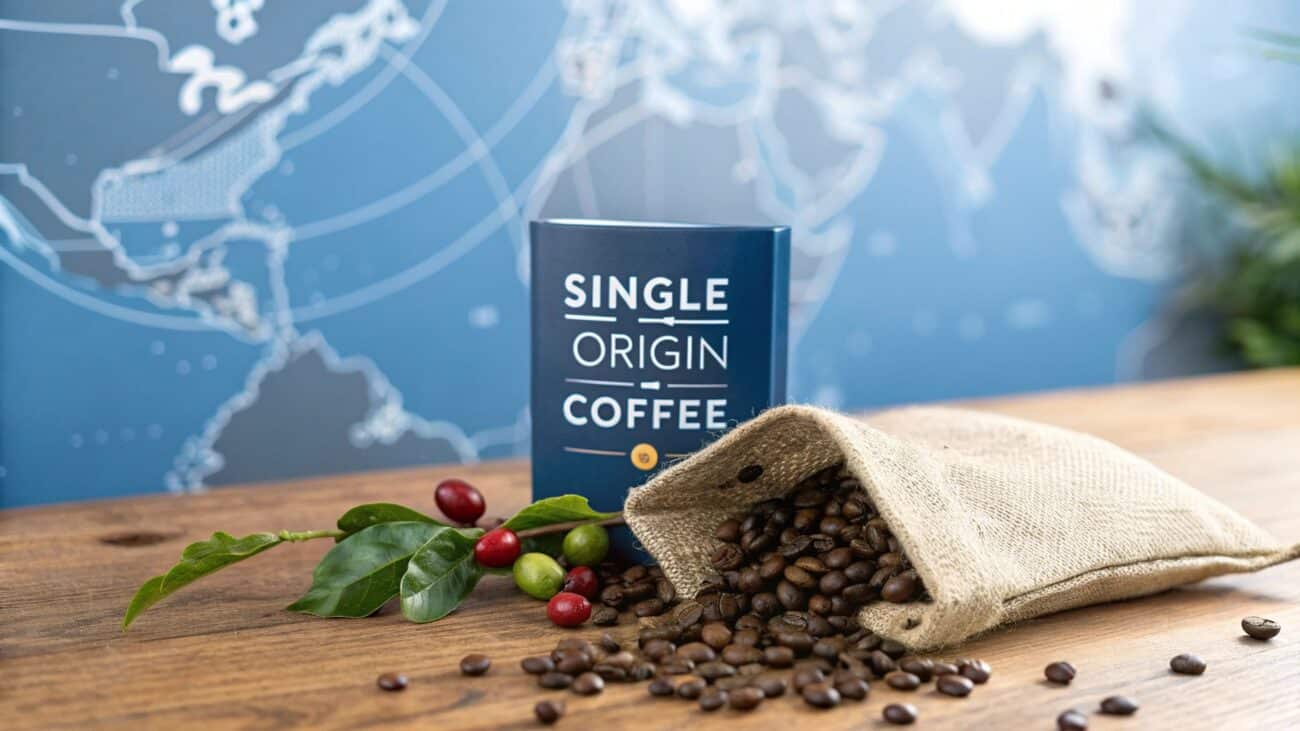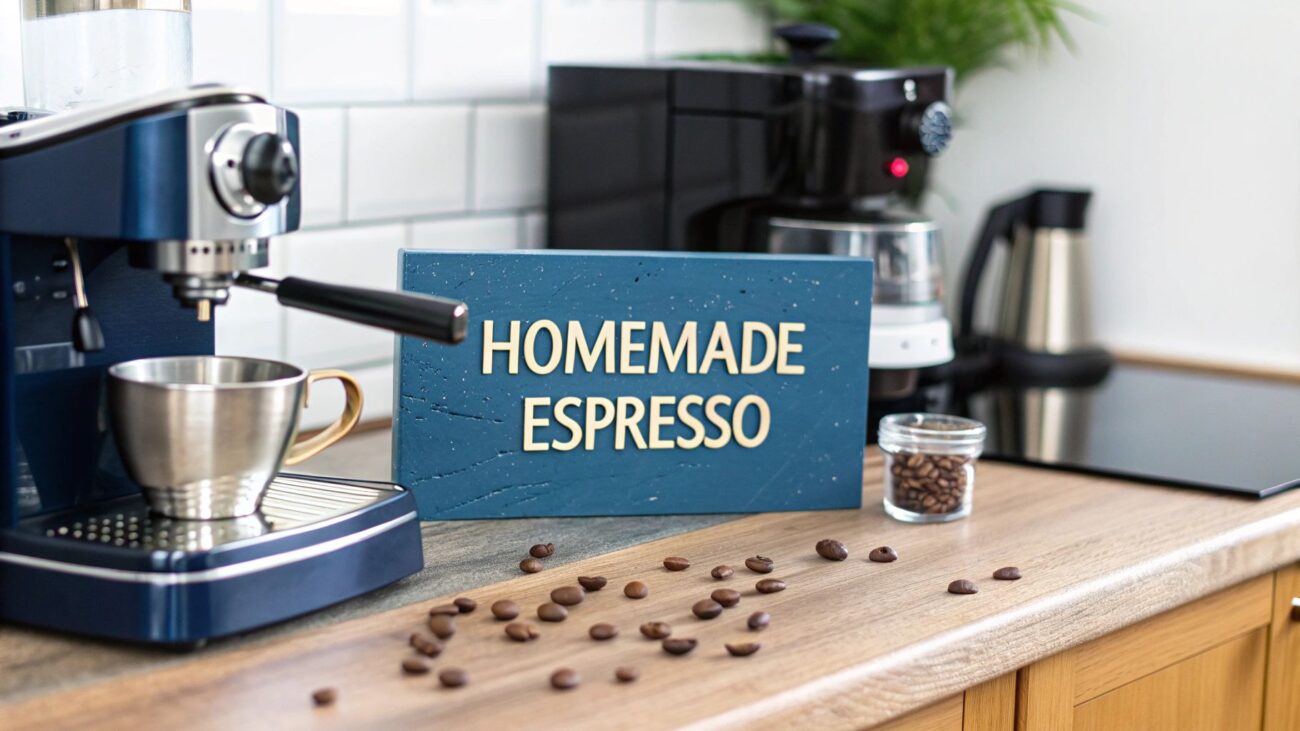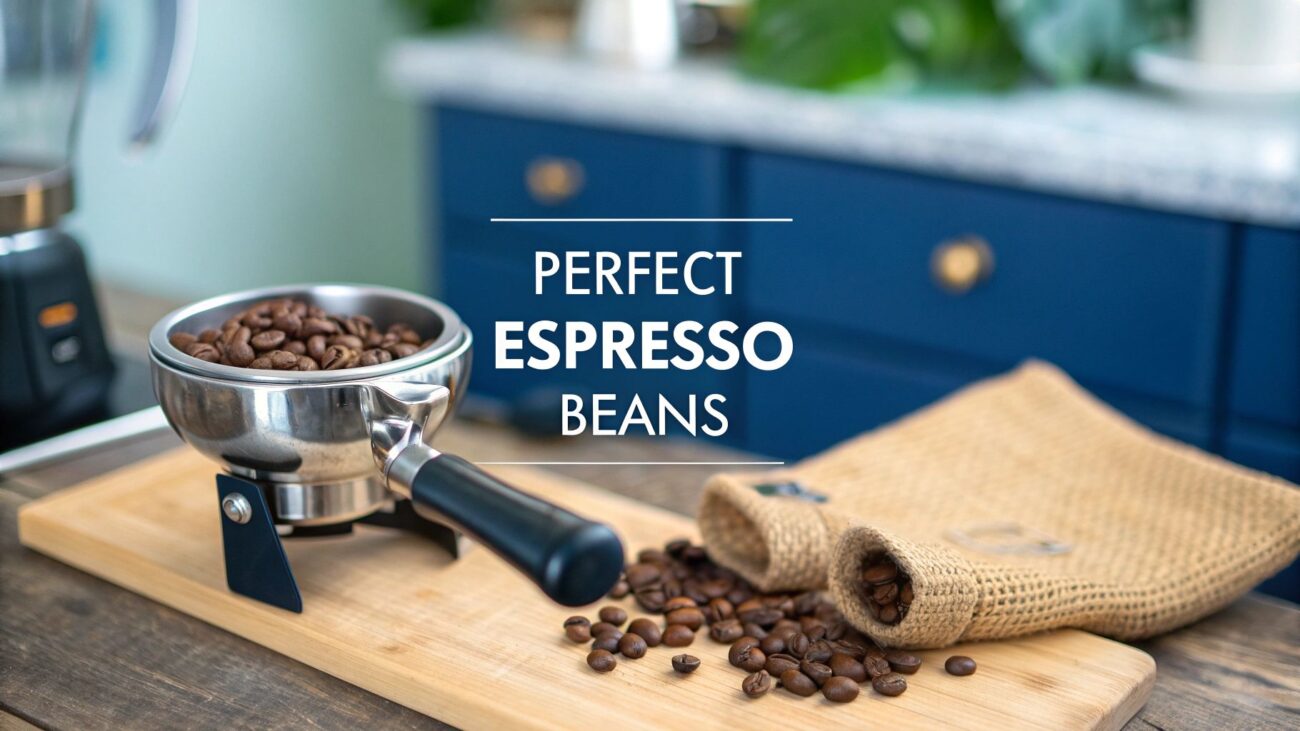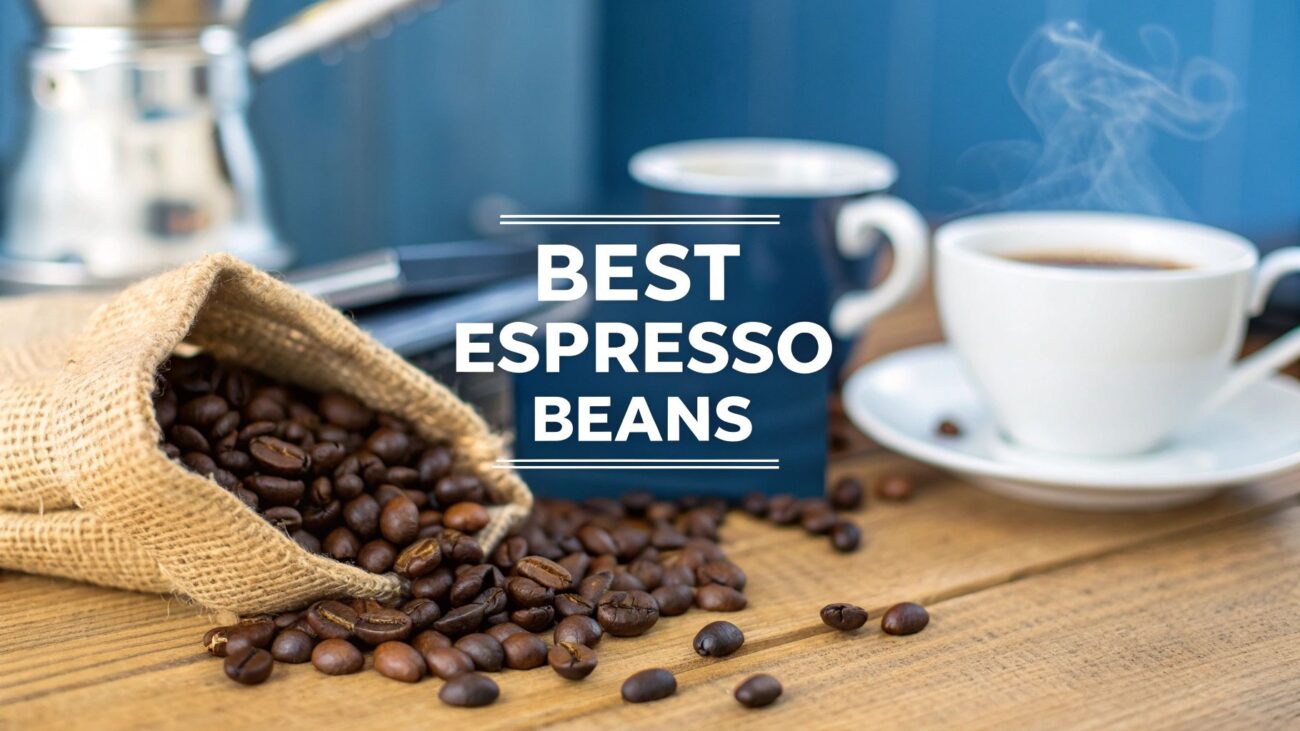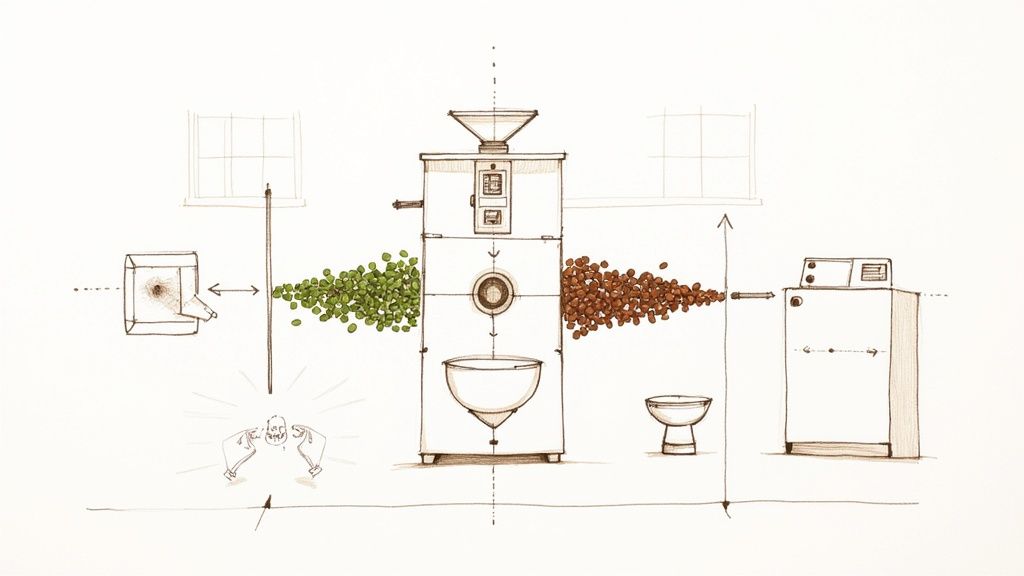Finding the Best Coffee Beans for Espresso
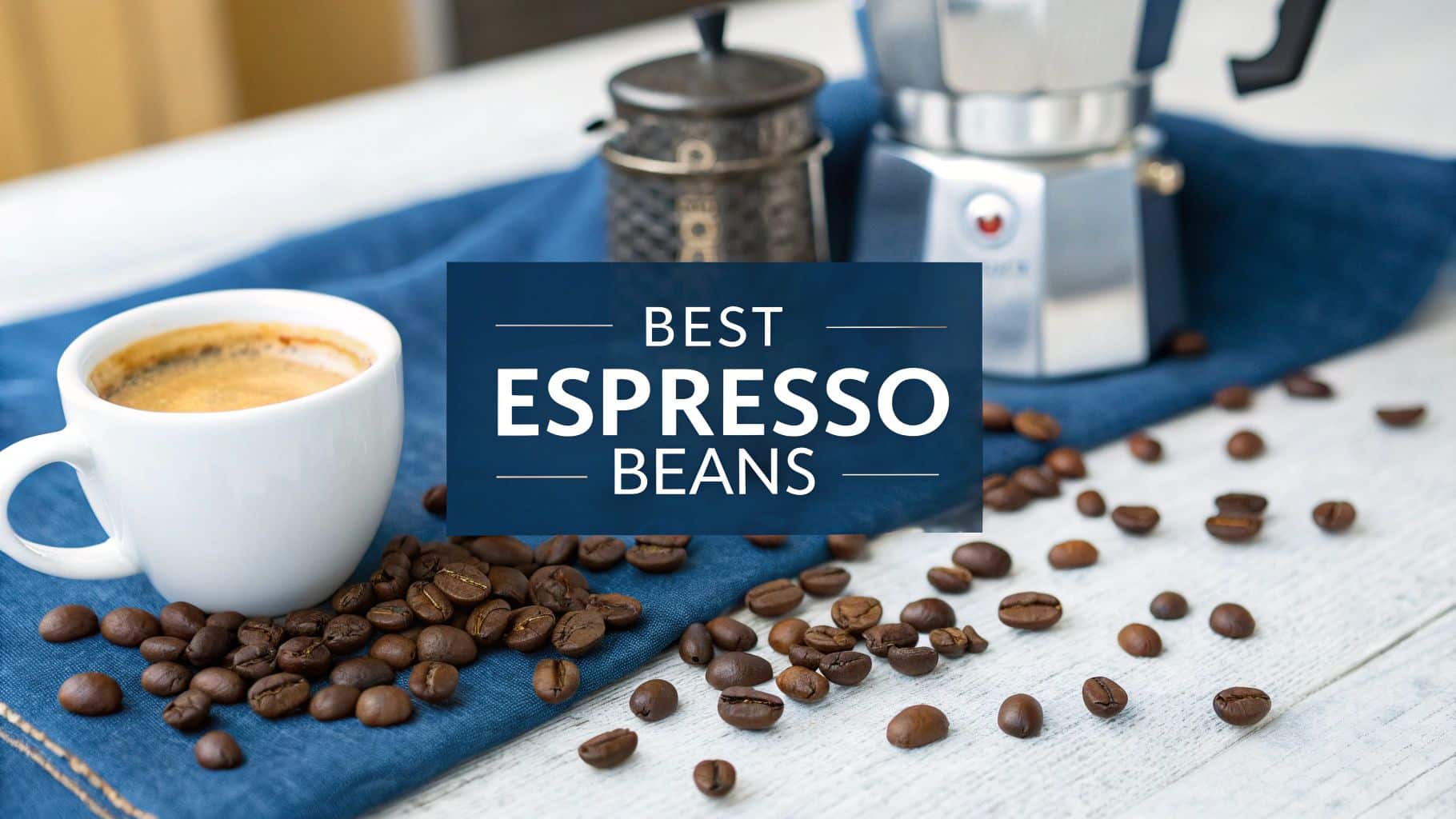
For a truly exceptional espresso, you'll want a medium to medium-dark roast with low acidity. Think classic Italian-style blends or single-origin beans from somewhere like Brazil—these often deliver the rich, chocolatey, and caramel notes that make a perfect shot. Your mission for café-quality espresso at home starts right here, with the beans themselves.
Your Journey to the Perfect Espresso Shot
The secret to a sublime espresso isn't just in the high-end machine or a perfectly calibrated grinder. While those are definitely important, the real magic begins long before you pull the shot. It starts with the coffee beans. Choosing the best beans for your espresso is the foundational step that dictates the flavour, aroma, and that gorgeous, rich crema you're chasing.
Think of an espresso bean as a tiny capsule of concentrated flavour. Your machine’s job is to blast that flavour out under intense pressure in less than 30 seconds. This process magnifies every single characteristic of the bean—both the good and the bad. A bean that makes a pleasant filter coffee might become unpleasantly sharp or sour when it meets the force of an espresso machine.
What Makes a Bean Great for Espresso?
So, what should you look for? The quest for the perfect espresso bean really comes down to a few key factors that work together to create a balanced, delicious shot. Get these right, and you're well on your way.
- Roast Profile: Generally, a medium to medium-dark roast is the sweet spot. This level of roasting develops the natural sugars in the bean, creating those lovely notes of caramel and chocolate while toning down the acidity, which can taste sour under pressure.
- Bean Origin: Where the coffee is grown massively shapes its flavour. Beans from Brazil often provide a classic nutty, chocolatey base, while those from Ethiopia can introduce bright, fruity notes if you’re feeling more adventurous.
- Freshness is Paramount: Coffee is a fresh product, period. The ideal window for using beans for espresso is between 7 to 21 days after their roast date. This gives the beans enough time to de-gas properly, leading to a much more stable extraction and a beautiful, thick crema.
The UK's passion for great coffee has never been stronger, and there's a growing appreciation for the nuances of speciality beans. The UK espresso coffee market was valued at approximately £382.49 billion and is projected to hit over £433.76 billion by 2032. This boom is largely driven by a preference for speciality Arabica beans, which now command the largest market share. You can explore more data on the UK coffee market's growth and trends to see how tastes are evolving.
Your espresso machine is an amplifier. It will take the core characteristics of a coffee bean and turn the volume up to ten. That's why starting with a bean that is inherently balanced, sweet, and low in acidity is the key to success.
Ultimately, this guide is here to demystify these core concepts and give you the practical knowledge to elevate your home coffee game. Consider this your first step toward brewing with real confidence.
Why the Roast Profile Is Crucial for Espresso
Imagine holding a green, unroasted coffee bean. It’s packed with potential for incredible flavour, but right now, it just tastes grassy and woody. It’s the roaster’s craft—the careful application of heat—that unlocks this potential, transforming the bean into the aromatic, delicious thing we know and love. When it comes to espresso, this transformation is everything.
The intense pressure and lightning-fast brew time of an espresso machine act like a magnifying glass on the coffee’s character. Any flaw in the roast gets amplified, leading straight to a disappointing shot. This is precisely why the roast profile is arguably the most important factor when you’re picking out the best beans for your espresso.
Think of it like toasting a marshmallow over a campfire. A light toast is sugary but a bit one-dimensional. Go too far, and you’re left with a burnt, bitter mess. The perfect espresso roast finds that delicious sweet spot, developing complex sugars and oils without scorching the delicate bean.
Light Roasts and Espresso: A Tricky Combination
A light roast is fantastic for highlighting the bright, acidic, and often floral notes of a coffee. That’s why it’s so popular for filter methods like a pour-over, where you have time to gently coax out those delicate flavours. For espresso, however, these same characteristics can spell trouble.
Lightly roasted beans are much denser and less soluble. An espresso shot is over and done in under 30 seconds, which often isn't enough time to properly dissolve their flavour compounds. More often than not, this results in a shot that’s overwhelmingly sour and thin-bodied, lacking that satisfying richness and crema we all chase.
Dark Roasts and the Risk of Bitterness
At the other end of the spectrum are the dark roasts. These beans are roasted longer and at higher temperatures, pushing oils to the surface and creating bold, smoky, and chocolatey flavours. While this sounds appealing, it’s a fine line to walk.
A very dark roast can easily obliterate the bean’s unique origin characteristics, replacing them with a generic, roasty bitterness. If taken just a little too far, the sugars carbonise, and you get an espresso that tastes ashy and hollow, with a thin crema that vanishes in seconds. Some classic Italian blends lean dark, but the goal is always richness, not char.
The Sweet Spot: Medium to Medium-Dark Roasts
This brings us to the gold standard for espresso: the medium to medium-dark roast. This roast level strikes the perfect balance, making it your most reliable bet for a consistently delicious shot.
By carefully developing the roast to a medium or medium-dark level, a roaster can caramelise the natural sugars, soften unpleasant acidity, and make the bean more soluble. This is the secret to a balanced, full-bodied extraction with a thick, stable crema every single time.
Here’s a quick rundown of why this profile just works:
- Balanced Acidity: The roast tames the sharp, citric acidity you find in lighter roasts, replacing it with a milder brightness that beautifully complements the deeper flavours.
- Developed Sweetness: It perfectly caramelises the sugars, creating those classic espresso notes of chocolate, toffee, and toasted nuts.
- Enhanced Body: The roasting process breaks down the bean's rigid structure, making it more soluble and ready to produce a syrupy, full-bodied shot.
- Optimal Oil Content: It encourages the development of the oils essential for a thick, gorgeous crema, but without bringing so much to the surface that they go stale quickly.
Understanding how different roasting approaches shape the final taste is a fascinating part of the coffee journey. To dive deeper, you can explore our detailed guide on how coffee roasting profiles are explained to master every brew. Ultimately, choosing a medium to medium-dark roast is your surest path to that rich, satisfying espresso you’re craving.
How Coffee Origins Shape Your Espresso's Flavour
Every single coffee bean is a time capsule, carrying the story of the place it was grown. Think of it like wine and its vineyard—the taste of your espresso is deeply connected to the coffee’s origin. This concept, known as terroir, covers everything from the soil and climate to the altitude of the farm.
Understanding these regional profiles is your secret weapon for finding the perfect espresso beans. It lets you move beyond generic descriptions and start choosing beans based on the exact taste you're craving, whether that’s a bold, intense shot or something more delicate and aromatic.
This global coffee-growing region is often called the 'Bean Belt'. It’s a band around the equator where the conditions for growing high-quality Arabica and Robusta beans are just right.
A Flavour Tour of the Bean Belt
Let's take a quick trip around the world to see how geography translates into the flavours in your cup. Each major coffee-growing region has a signature profile, a direct result of its unique environment.
- South America (Brazil & Colombia): Beans from this part of the world are the backbone of many classic espresso blends. Brazilian coffees are famous for their low acidity and full body, bringing comforting notes of chocolate, nuts, and caramel. Colombian beans often add a touch of bright, fruity sweetness to the mix.
- Central America (Guatemala & Costa Rica): These coffees are celebrated for their balance and complexity. You'll often find a crisp, clean acidity reminiscent of apples or citrus, paired with a toffee-like sweetness and a smooth, satisfying body.
- Africa (Ethiopia & Kenya): If you're looking for vibrant and exotic flavours, this is where you'll find them. Ethiopian beans, from the birthplace of coffee, can be incredibly floral and tea-like, bursting with notes of blueberry or bergamot. Kenyan coffees are prized for their bright, wine-like acidity and juicy, berry-like character.
This growing appreciation for distinct flavour profiles is reflected right here in UK coffee culture. Coffee shops and cafés now account for 7.1% of the total eating-out market turnover, with over 12,229 outlets nationwide. It’s clear we’re all looking for premium espresso that showcases the unique characteristics of its origin.
Single Origin or Blend: Which Is Better?
This brings us to a common fork in the road: should you choose a single-origin coffee or a blend for your espresso? Honestly, the answer depends entirely on what you're looking for.
A single-origin coffee comes from one specific farm or region. Choosing single-origin is like listening to a solo artist—you get to experience the pure, unadulterated character of that one place. It’s the perfect way to explore the distinct flavours of Ethiopia or the chocolatey depths of a Brazilian bean.
A blend, on the other hand, is like an orchestra. A skilled roaster combines beans from different origins to create a more complex and balanced flavour profile. The goal is to produce a consistent and harmonious taste, where the strengths of one bean complement the weaknesses of another.
Blends are often the safest bet for a classic, crowd-pleasing espresso, offering reliability and balance. Single-origin beans offer a more adventurous journey, showcasing the unique and sometimes surprising flavours of a specific terroir.
For home baristas, starting with a well-crafted blend can provide a dependable foundation for making great espresso. As your confidence grows, experimenting with single-origin beans can open up a new world of taste and help you pinpoint exactly what you love. If you're curious to learn more, check out our guide on what single-origin coffee is and why it's so special.
Ultimately, exploring different origins is one of the most exciting parts of the coffee journey. It transforms the simple act of brewing an espresso into a global tasting tour, right from your own kitchen.
Mastering the Grind and Protecting Bean Freshness
So, you’ve carefully picked the perfect beans, weighing up their origin and roast profile. Fantastic. But even the best espresso beans in the world can be let down in the final moments before brewing. The journey from a whole bean to a sublime shot of espresso really comes down to two things: getting the grind just right and protecting your beans from their mortal enemies.
Think of grinding coffee like a chef chopping ingredients. If the pieces are all different sizes, they’ll never cook evenly. It’s the exact same with coffee. An inconsistent grind leads to uneven extraction, where some grounds give up their flavour too quickly (over-extraction) and others don’t give up enough (under-extraction). The result? A muddled, unbalanced shot.
This is precisely why a quality burr grinder is the single best investment you can make for your home espresso setup. Unlike blade grinders, which just violently chop beans into random, uneven fragments, burr grinders use two revolving abrasive surfaces to crush them into a beautifully uniform size. For a balanced, sweet, and repeatable espresso, this consistency is non-negotiable.
Why Grind Size Is Everything for Espresso
Espresso is a game of speed and pressure. Your machine forces hot water through a tightly packed puck of coffee grounds in about 25-30 seconds. A fine, consistent grind creates the necessary resistance to slow the water down, giving it just enough time to pull out all those delicious oils and soluble compounds that make espresso so special.
If the grind is too coarse, water will gush right through. You’ll get a weak, sour, and under-extracted shot with a sad, thin crema. Go too fine, and the water will struggle to push through at all, leading to a painfully slow, over-extracted shot that tastes bitter and burnt. The sweet spot for an espresso grind is similar to fine table salt—it provides the ideal resistance for that perfect extraction.
Your grinder isn't just an accessory; it's a precision tool. It has more impact on the final taste of your espresso than almost any other piece of kit. Investing in a good burr grinder gives you the control you need to unlock your beans' full potential.
Protecting Your Beans from the Four Enemies
Once you've dialled in your grind, the next mission is to preserve the freshness of the beans you haven't used yet. Coffee has four natural enemies that will rapidly degrade its delicate flavours and aromas. Keeping them at bay is crucial.
The Four Enemies of Coffee Freshness are:
- Oxygen: This is coffee's number one adversary. Oxidation kicks in the moment you open the bag, causing beans to lose their vibrancy and go stale.
- Light: Direct sunlight and even strong indoor lighting can break down the fragile aromatic compounds in coffee, leaving it tasting flat and lifeless.
- Heat: Storing your coffee near a heat source, like an oven or a sunny window, will speed up the staling process by accelerating chemical reactions inside the bean.
- Moisture: Coffee is hygroscopic, which is a fancy way of saying it absorbs moisture and odours from the air around it. This can completely ruin the flavour and integrity of your beans.
Thankfully, the best way to combat these threats is simple. Keep your beans in an airtight, opaque container and store them in a cool, dark place like a pantry or cupboard. Steer clear of the fridge or freezer, as condensation can introduce moisture and damage the beans’ cellular structure. Proper storage ensures every shot you pull tastes as fresh and vibrant as the roaster intended.
For a deeper dive into the best practices, our complete guide on how to store coffee beans has all the details you need to keep your coffee at its absolute peak.
Our Top Espresso Bean Recommendations
Now that you’ve got a handle on roasts, origins, and the science behind the grind, it’s time to put that knowledge to the test. This is where the theory hits the taste buds. We’ve pulled together a few of our favourite coffees, each one handpicked and roasted specifically for the intense, high-pressure world of espresso.
Think of this as your practical guide to choosing the perfect beans for your machine. Each recommendation ties directly back to what we've just covered, showing you exactly how certain origins and roast profiles come together to create a truly brilliant shot.
For the Traditionalist: The Classic Italian Blend
If your dream espresso is rich, bold, and syrupy with a thick, lasting crema, then our signature Seven Sisters Blend is your perfect match. This is the quintessential espresso experience, crafted for pure depth and balance.
We start with high-quality Brazilian beans to lay down a solid foundation of dark chocolate and toasted almond. Then, we bring in a touch of beans from Guatemala to add a subtle layer of sweetness. It’s a medium-dark roast, developed to mellow out the acidity and boost the body, which means it also holds its own beautifully in milk drinks like cappuccinos and lattes.
This blend is engineered for consistency and classic flavour. It's forgiving enough for home baristas and delivers that timeless, comforting coffee taste that has defined espresso culture for generations.
For the Adventurous Palate: A Single-Origin Star
For those who prefer an espresso that’s brighter and more nuanced, we highly recommend our single-origin Ethiopian Yirgacheffe. This coffee is a true celebration of its roots, offering a completely different but equally captivating espresso experience.
Roasted to a medium level, these beans produce a shot with vibrant floral aromas, a delicate tea-like body, and bright notes of lemon citrus and stone fruit. It’s a fantastic example of how a lighter espresso roast can showcase the unique terroir of a region without veering into sour territory. This one is absolutely stunning as a straight espresso or a macchiato.
The infographic below really brings home the importance of grind size, showing why that super-fine setting is non-negotiable for espresso.
As you can see, the fine particles of an espresso grind create the resistance needed for a proper extraction—a world away from the coarse grounds you'd use for a French press.
Choosing Your Perfect Match
Ultimately, the best espresso beans are the ones that make you excited to turn on your machine in the morning. Your own preference is the most important factor, and honestly, experimenting is half the fun. Do you find yourself leaning towards comforting, chocolatey notes, or are you drawn to bright, fruity flavours?
To help you decide, we've put together a direct comparison of our top recommended beans. This table should help you find your perfect match.
Seven Sisters Espresso Bean Comparison
| Bean Name | Origin | Roast Level | Primary Flavour Notes | Best For |
|---|---|---|---|---|
| Seven Sisters Blend | Brazil & Guatemala | Medium-Dark | Dark Chocolate, Toasted Almond, Caramel | Classic espresso, lattes, and cappuccinos |
| Ethiopian Yirgacheffe | Ethiopia | Medium | Lemon Citrus, Bergamot, Floral Notes | Straight espresso, macchiatos, and exploring |
The best way to develop your palate and figure out what you truly love is to simply start exploring. To see our full range and find your next favourite, browse our complete collection of specialty coffee beans online.
Happy brewing
Brewing Your Best Espresso Shot at Home
Right, let's bring all this together and turn that knowledge into a truly delicious shot of espresso. You've now got a solid grasp of the big picture: choosing the right roast, understanding how origin shapes the flavour, the importance of grinding fresh, and why proper storage is non-negotiable. Think of these as the pillars for pulling consistently great, café-quality espresso in your own kitchen.
The goal here isn't just to follow a recipe, but to feel confident enough to experiment and explore. You’re on the path from coffee lover to skilled home barista, ready to pull balanced, flavourful shots crowned with that thick, beautiful crema every single time.
This passion for home brewing is bigger than just you and me. Across the UK, the way we drink espresso at home is changing, with a clear shift towards better quality beans. While Brits purchase around 29.8 million kilograms of coffee from cafes and shops, that figure is expected to climb to 34.5 million kilograms by 2028—and a huge chunk of that is espresso-specific coffee for home machines. It just goes to show there’s a growing community of people like you who really value great beans as part of their daily ritual.
Your Final Espresso Checklist
To get you started on the right foot every time you step up to your machine, here’s a simple checklist. Follow these steps, and you'll have a reliable framework for success.
- Select the Right Beans: Kick things off with a medium to medium-dark roast that’s been specifically profiled for espresso.
- Grind Just Before Brewing: Weigh your dose accurately and use a burr grinder to get that fine, consistent grind. It makes all the difference.
- Prepare Your Puck: Get those grounds nice and even in your portafilter before tamping with firm, level pressure. No crooked tamps!
- Pull Your Shot: Keep an eye on the clock. You’re aiming for an extraction time of about 25-30 seconds.
- Taste and Adjust: Now for the fun part. Is it a bit sour? Grind finer. Too bitter? Go a little coarser next time.
Remember, the perfect espresso is a blend of science and art. Use these principles as your starting point, but let your taste buds be the final judge. At the end of the day, your personal preference is the only thing that really matters.
This checklist gives you a fantastic foundation, but the journey of perfecting your technique is ongoing. To take your skills even further, we've put together a more detailed guide on how to make espresso at home packed with extra tips and tricks.
Your Espresso Questions, Answered
Jumping into the world of espresso is exciting, but it definitely brings up a lot of questions. To help you get your technique dialled in, we’ve put together some clear, expert answers to the most common queries we hear about choosing and brewing the perfect espresso beans.
Can I Use Any Coffee Beans for Espresso?
Technically, you can put any coffee bean into your machine, but you’ll get far, far better results with beans roasted specifically for espresso. These roasts are carefully developed to be more soluble, which is just a fancy way of saying their rich flavours can be pulled out properly in the short, high-pressure brew time of an espresso shot.
If you try to use a lighter roast meant for a filter coffee, you’re usually in for a disappointing, watery cup. That quick 25-30 second extraction just isn’t long enough to unlock its potential, leaving you with a shot that tastes unpleasantly sour and thin. Sticking to a dedicated espresso roast is your best bet for that classic rich body, deep sweetness, and a thick, lasting crema.
What Is the Difference Between Arabica and Robusta Beans?
Arabica and Robusta are the two big players in the coffee world, and they couldn’t be more different in the cup. Getting to know them is key to finding the espresso beans that perfectly match your taste.
- Arabica beans make up the vast majority of the world's speciality coffee. They're prized for their complex, aromatic flavours—think sweet, floral, and fruity notes with a pleasant, bright acidity. A 100% Arabica espresso is all about smoothness and nuance.
- Robusta beans are much hardier plants that pack a serious caffeine punch. They deliver a bolder, stronger, and more "classic" coffee flavour with very little acidity. While you won't often see them as a speciality single origin, a little bit of Robusta is the secret weapon in many traditional Italian espresso blends.
You’ll find a touch of Robusta in many classic espresso blends for a good reason: it helps produce a remarkably thick, stable, and long-lasting crema. It also adds that powerful kick and deep, earthy body that many people think of when they imagine a traditional espresso.
How Long After Roasting Should I Use My Beans?
Freshness is everything in coffee, but with espresso, "too fresh" is a real thing. Right after roasting, coffee beans start releasing trapped carbon dioxide in a process called de-gassing. If you try to brew with beans during this initial phase—usually the first few days—the escaping CO2 messes with the water's ability to properly extract the coffee, leading to a horribly erratic and sour shot.
The sweet spot for brewing espresso is generally between 7 and 21 days after the roast date. This window gives the beans enough time to settle down while still being packed with vibrant flavour and aroma. After about three weeks, they start to go stale, and your shots will lose their complexity and crema. Always look for a "roasted on" date on the bag, not just a "best before."
Ready to put your knowledge into practice and brew your best espresso yet? Explore our curated selection of freshly roasted, speciality-grade coffee beans at Seven Sisters Coffee Co. Find your perfect espresso beans today and taste the difference that quality and freshness make.

